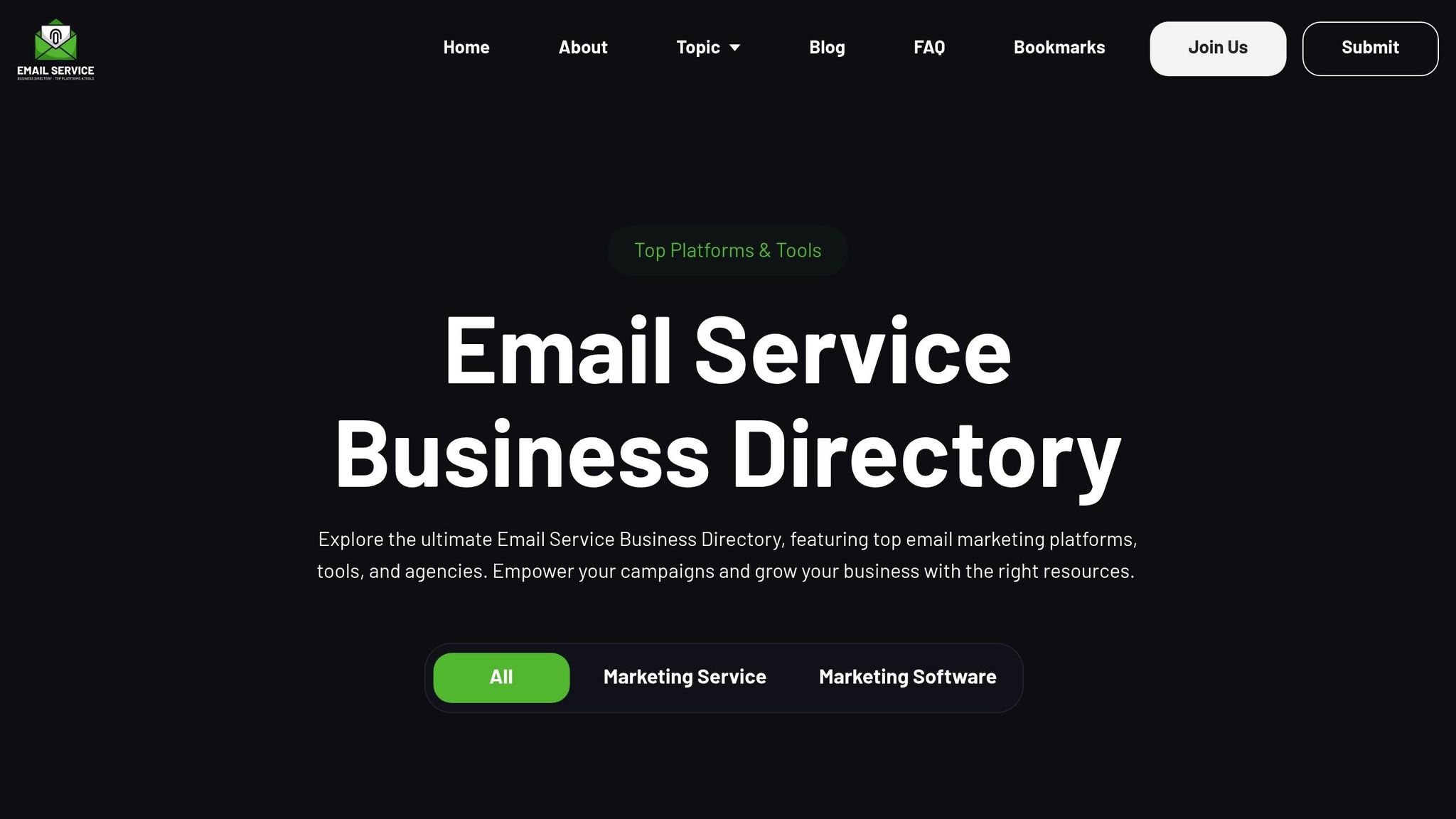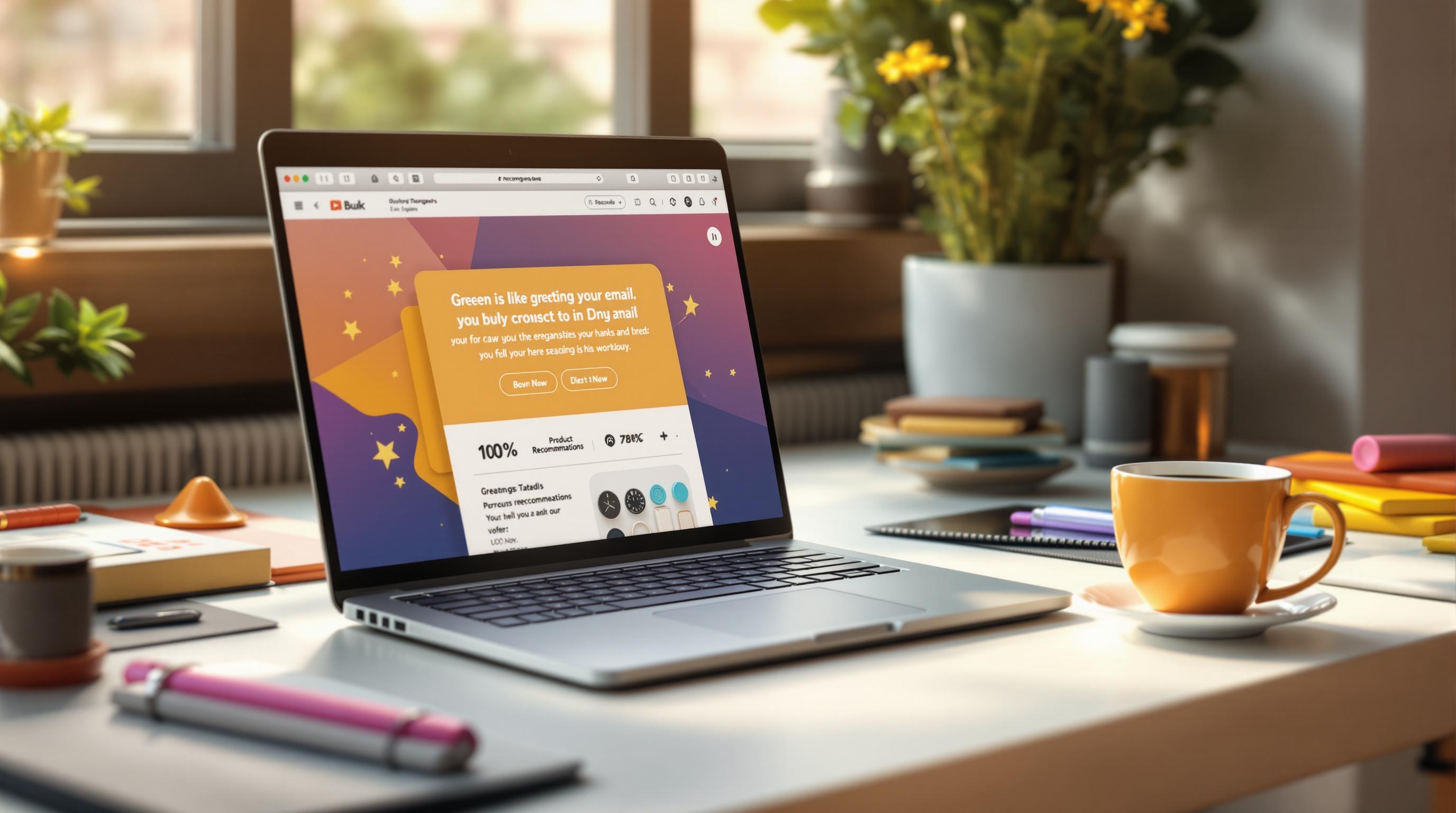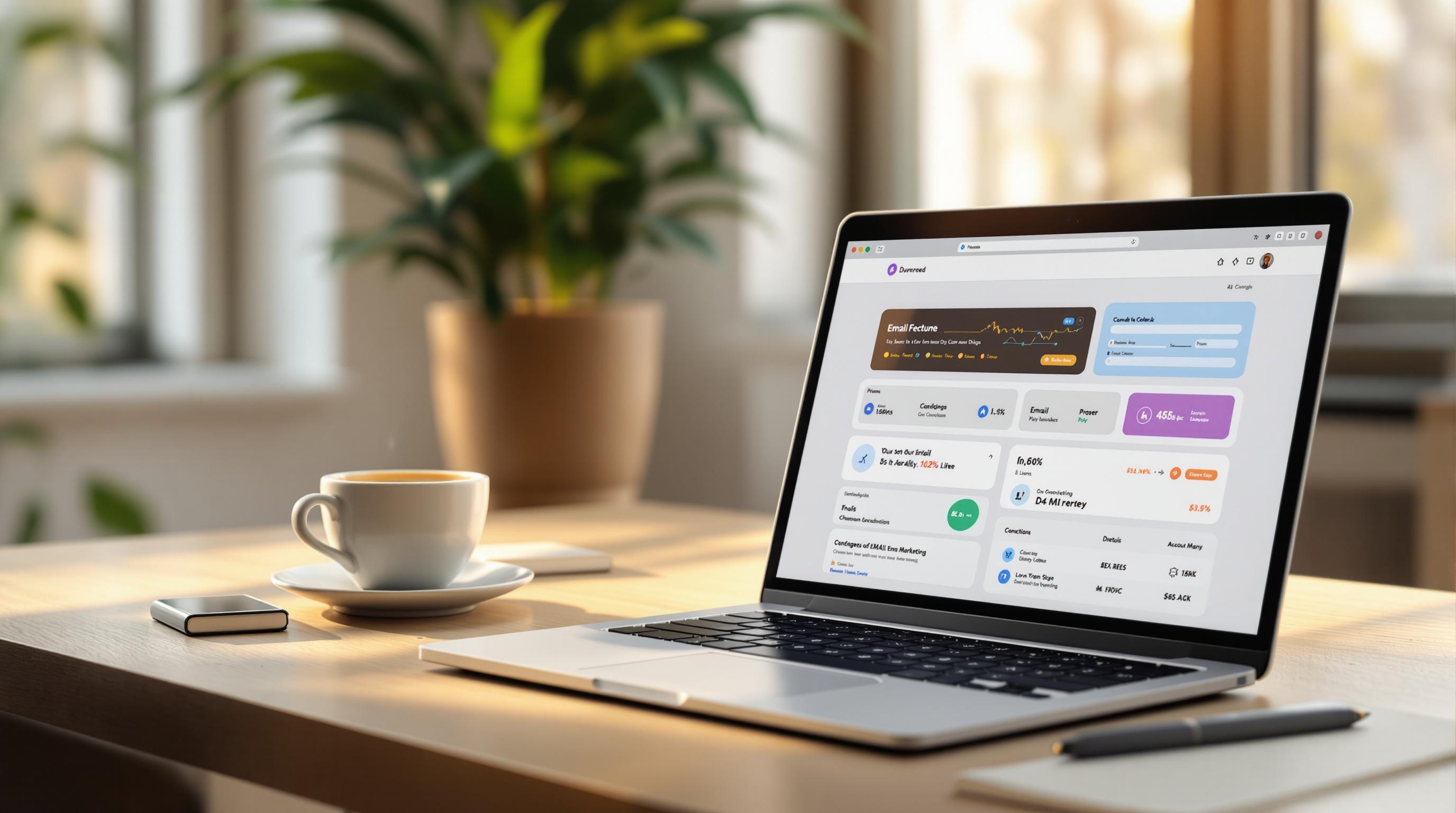Demographic segmentation in B2B email marketing is all about targeting the right audience with the right message. Unlike B2C, where you often deal with individuals, B2B involves multiple decision-makers, each with unique priorities. Here's what you need to know:
- Job Title & Department: Tailor emails to specific roles like CFOs (focused on ROI) or IT directors (interested in tech specs). This can boost open rates by 14.31% and clicks by 100.95%.
- Company Size & Industry: Address the unique challenges of small businesses versus large enterprises or industries like healthcare versus manufacturing.
- Geographic Location: Adapt messaging based on regional needs, climate, or business culture.
- Seniority & Authority: Focus on decision-makers versus influencers to ensure content aligns with their level of responsibility.
- Advanced Tools: Use AI-driven platforms for real-time segmentation and dynamic targeting, leading to higher engagement and revenue.
Segmented campaigns can generate up to 760% more revenue than generic emails. Start simple, refine over time, and leverage tools to scale effectively.
The Email Segmentation That Every B2B Tech Startup Needs
1. Segment by Job Title and Department
Segmenting by job title and department allows you to address your audience's specific challenges and goals. Whether you're speaking to a procurement manager or a CTO, tailoring your message to their role ensures it resonates with their unique needs.
Relevance to B2B Audiences
Every role within an organization has its own priorities and concerns. For instance, CFOs are laser-focused on ROI and cost efficiency, while IT directors care more about technical compatibility and system integration. This distinction matters - a segmented email campaign can lead to 14.31% more opens and 100.95% more clicks compared to non-segmented campaigns.
Job titles also reveal decision-making authority. A CTO, for example, might oversee company-wide technology adoption, while an intern may only require limited, temporary access. By addressing these role-specific priorities, you naturally increase engagement and relevance.
Impact on Email Campaign Engagement
When content aligns with the recipient's professional context, engagement skyrockets. For example, an inventory update might be crucial for a procurement team but irrelevant to C-level executives. On the other hand, IT teams and senior decision-makers are more likely to engage with content about data security policies. Effective email segmentation has been shown to drive a 760% increase in revenue.
Ease of Implementation
The beauty of job title and department segmentation lies in its simplicity. According to Jaina Mistry, Director of Brand and Content Marketing at Litmus:
"Email segmentation is the simplest way to ensure you're sending the right message to the right person at the right time. You don't need any technical skills to create segments of your audience, either. Most - if not all - ESPs will give you that feature out-of-the-box. The only thing you need to decide is what segments you want to create."
Getting started is straightforward. Collect data on job titles and departments during sign-up, run surveys to gather preferences, and analyze click behavior from past campaigns to refine your segmentation strategy. Not only is this approach highly effective, but it’s also easy to implement.
Scalability for Different Business Sizes
This segmentation strategy works for businesses of all sizes. Even small companies can group their audience into broad categories like Sales, Marketing, and Operations. Larger organizations, on the other hand, can benefit from more detailed segmentation, such as targeting a Senior Sales Manager versus a Marketing Automation Specialist. The flexibility of this approach ensures its value, no matter the scale of your business.
2. Segment by Company Size and Industry
Breaking down your audience by company size and industry is a smart way to craft B2B emails that hit the mark. After all, a startup with a team of 10 faces completely different hurdles compared to a Fortune 500 giant. Similarly, a healthcare provider has entirely different priorities than a manufacturing company.
Why It Matters for B2B Audiences
B2B email campaigns need to reflect the unique realities of different businesses. Segmenting by company size and industry allows you to acknowledge that a small tech startup requires different solutions than a well-established enterprise. Likewise, financial services firms deal with strict regulatory demands that don’t apply to retail businesses. By addressing these distinctions, you can create messages that resonate with specific challenges tied to size and industry.
For example, a small business owner might be laser-focused on staying within budget and scaling operations, while an enterprise executive is likely more concerned with compliance and integration. Industry-specific needs add another layer of complexity - healthcare organizations must prioritize HIPAA compliance, while manufacturing companies might worry about supply chain disruptions.
Boosting Engagement with Tailored Content
When emails speak directly to the recipient’s situation, engagement skyrockets. A small business owner is far more likely to click on an email that highlights cost-effective solutions for growing teams than one that promotes enterprise-grade features. Similarly, industry-specific content grabs attention because it shows a deep understanding of sector-specific challenges and regulations.
This kind of segmentation makes your emails feel personal and relevant, which can significantly improve campaign performance.
How to Get Started
Implementing this strategy isn’t complicated. Start by gathering data on company size and industry during lead generation or through signup forms. Make sure your emails use language and data that align with the recipient’s business context.
You can begin with simple company size categories, such as:
- Small businesses (1–50 employees)
- Medium businesses (51–500 employees)
- Large enterprises (500+ employees)
For industry segmentation, focus on the sectors you serve most often. Highlight product benefits that address their specific needs or offer resources tailored to their challenges. For example, you could provide a downloadable guide on HIPAA compliance for healthcare providers or a whitepaper on supply chain solutions for manufacturers.
Scaling for Businesses of All Sizes
This segmentation approach is flexible enough to grow with your business. Smaller companies can start with a few basic segments, while larger organizations might adopt more complex strategies to cater to diverse customer groups.
Big players often use tiered segmentation to fine-tune their offerings. For instance, HubSpot divides its audience into Starter, Professional, and Enterprise tiers, while Slack offers plans like Free, Standard, Plus, and Enterprise Grid to cater to everyone from freelancers to Fortune 500 companies.
To keep your strategy effective, monitor your segments regularly. Use analytics tools to track how different groups respond to your campaigns and adjust your approach as needed. This continuous refinement ensures your emails stay relevant as business needs evolve.
3. Segment by Geographic Location and Region
Geographic segmentation takes your B2B email campaigns a step further by factoring in where your prospects are located. Think about it: a tech company based in Silicon Valley likely operates differently from one in rural Kansas, and a manufacturing firm in Detroit faces challenges that might not apply to a similar business in Miami.
Why Location Matters for B2B
Where a business operates influences its priorities and challenges in ways that go beyond time zones. Climate, for instance, can shape product needs - businesses in Phoenix may prioritize cooling systems, while those in Seattle might focus on heating. Population density also plays a role, affecting logistics and market access. Even regional business cultures vary: companies in the Northeast often value efficiency and direct communication, while businesses in the South might emphasize relationship-building and personal connections. Another important factor is digital infrastructure - access to reliable internet and varying levels of digital literacy can influence how your message is received and understood.
Tailoring your email campaigns to these regional nuances can make your content more relevant and effective, especially in the B2B space.
Boosting Engagement Through Targeting
Emails that are targeted to specific segments are four times more likely to be opened. Even more impressively, segmented emails can generate 18 times more revenue than generic, one-size-fits-all messages. When your content reflects the unique aspects of a recipient's location, it feels more relevant, increasing the likelihood of engagement. For example, incorporating location-specific terms or referencing local events in subject lines can dramatically improve open rates. Businesses that regularly segment their email campaigns have reported better deliverability, more sales leads, and higher revenue as a result.
How to Get Started
Geographic segmentation is easier to implement than you might think. You can gather location data through sign-up forms, IP address tracking, purchase history, or CRM tools. Many email marketing platforms even capture IP-based location data automatically, giving you a head start. Consider segmenting your audience by factors like country, region, city, ZIP code, climate, or time zone. Start with broad categories and refine them as you collect more data. From there, you can tailor your campaigns with location-specific offers, holiday promotions, invitations to local events, or case studies that highlight regional success stories.
Adapting to Different Business Sizes
Whether you're running a small business or a multinational corporation, geographic segmentation can work for you. Smaller businesses might focus on hyper-local marketing, targeting specific neighborhoods or business districts. For instance, a local IT services company could create personalized campaigns for nearby prospects. Larger companies, on the other hand, can use advanced analytics to segment audiences across multiple regions, countries, or even cities. The level of detail you use will depend on your goals, audience, and resources. A startup might focus on just a few key areas, while a global enterprise could manage campaigns tailored to dozens of countries.
sbb-itb-6e7333f
4. Segment by Seniority and Decision-Making Authority
Pinpointing key decision-makers can dramatically improve your email marketing outcomes. In the B2B world, the person identifying a problem isn’t always the one approving the budget. For instance, a marketing specialist might recognize the need for a new email platform, but it’s the VP of Marketing who holds the purse strings and makes the final decision. By segmenting your audience based on seniority and decision-making authority, you ensure that every stakeholder receives content tailored to their role.
Relevance to B2B Audiences
B2B buying decisions are rarely straightforward. They often involve several stakeholders, each with different levels of influence. Studies reveal that more than 80% of businesses include four or more people in the buying process, and nearly half of B2B decision-makers identify themselves as the ultimate authority on decisions. This complexity means your email campaigns must speak to a variety of roles within an organization.
Take this example from Email on Acid: A Marketing Specialist might search for an email quality assurance tool after encountering campaign errors. A Senior Email Marketing Manager then evaluates potential solutions, leveraging their industry expertise. Finally, a Director or VP of Marketing decides whether the solution aligns with the budget. Once approved, email developers and marketing teams become the primary users. Each of these stakeholders has unique priorities, and your messaging should reflect that.
Impact on Email Campaign Engagement
Targeted segmentation can significantly enhance campaign performance. In fact, some personalized campaigns have reported a 760% increase in revenue, with 90% of top marketers noting better profitability through tailored messaging. When you understand your audience’s roles, you can craft messages that resonate deeply. For instance:
- C-suite executives care about ROI and long-term strategic benefits.
- Mid-level managers focus on implementation and operational efficiency.
- End users prioritize ease of use and how the solution improves their daily tasks.
By addressing these specific concerns, your emails become more engaging and impactful.
Ease of Implementation
Implementing seniority-based segmentation doesn’t have to be complicated. Many companies already gather job titles during lead capture, which provides a starting point. To refine this data, you can:
- Research prospects on LinkedIn.
- Review company websites for organizational insights.
- Track engagement patterns to identify decision-making hierarchies.
Based on this information, you can create three primary segments:
- Decision-makers: C-suite executives, VPs, and Directors.
- Influencers: Managers, specialists, and analysts.
- Users: Individual contributors and team members.
As you collect more data, these categories can be adjusted for greater precision.
Email on Acid emphasizes the importance of this approach:
"As an email marketer, you need to have a clear understanding of the customer journey. How do each of the personas within an organization play a role in that journey? What valuable information do they need to know and what objections must be overcome to take the next steps?"
Scalability for Different Business Sizes
This segmentation strategy is flexible enough to suit businesses of all sizes. For a small tech startup, decision-making might be centralized, with founders or senior managers overseeing multiple roles. In contrast, a large enterprise may involve 10–12 specialized stakeholders, each requiring tailored messaging.
Account-Based Marketing (ABM) highlights the effectiveness of understanding these dynamics. According to research, 88% of senior B2B marketers report higher conversion rates with ABM, which relies heavily on mapping decision-making structures. Additionally, 90% of professionals agree that at least one member of the decision-making team often tries to influence the outcome.
5. Use the Email Service Business Directory for Advanced Segmentation

Building on earlier segmentation strategies, using a specialized platform can take your targeting to the next level. By choosing an email marketing platform with advanced segmentation features, you can fine-tune your B2B campaigns. The Email Service Business Directory is a powerful resource that simplifies the process of finding email marketing tools equipped with robust segmentation capabilities. Instead of spending weeks researching, this directory lets you compare features, pricing, and capabilities to quickly identify the best solution for your needs.
Why It Matters for B2B Audiences
B2B marketing comes with its own set of challenges, especially when it comes to segmentation. Unlike B2C marketing, which often focuses on simpler demographic details like age or gender, B2B segmentation involves managing complex buying processes and multiple decision-makers. The Email Service Business Directory addresses these challenges by showcasing platforms that specialize in firmographic data, behavioral tracking, and predictive analytics.
Modern email service providers are increasingly incorporating AI-driven personalization and advanced automation. These tools allow you to segment audiences by company-specific traits like industry, revenue, employee count, and growth stage. For example, a software company can approach startups with fewer than 50 employees differently than it would target enterprise clients with over 1,000 employees.
Boosting Engagement with Advanced Segmentation
Advanced segmentation doesn’t just refine your targeting - it can significantly enhance campaign results. Marketers who adopt advanced segmentation strategies have reported a staggering 760% increase in revenue.
Platforms featured in the directory offer real-time behavior analysis to create dynamic segments. These tools include features like lead scoring, dynamic list updates, and integrated analytics. For instance, if a prospect downloads a pricing guide, they can be automatically moved from a general awareness segment to a high-intent buyer segment. This level of responsiveness ensures your emails are always relevant and timely, leading to higher open and click-through rates.
Simplicity in Implementation
You might think advanced segmentation sounds complicated, but it’s easier to implement than you’d expect. The Email Service Business Directory categorizes platforms by complexity, helping you find one that matches your current capabilities and future growth plans.
| Segmentation Level | Typical Number of Segments | Ideal for |
|---|---|---|
| Basic | 2-4 | Small businesses, new to segmentation |
| Intermediate | 5-7 | Growing businesses with diverse audiences |
| Advanced | 8-12 | Enterprises with complex product lines |
| Hyper-segmented | 12+ | Specialized campaigns, transactional emails |
The directory also highlights tools with data enrichment and integration features. Many platforms can pull data from external sources, letting you start with simple demographic information and gradually build more sophisticated segments as you gather additional insights.
Industry expert Dela Quist underscores the value of this approach:
"The time you spend segmenting is returned multiple times in improved results".
Scalable Solutions for Every Business Size
Segmentation needs vary widely depending on a company’s size and resources. Small businesses might start with basic demographic splits, while enterprises often require advanced AI-driven segmentation to manage millions of contacts across multiple product lines. The Email Service Business Directory’s tiered approach ensures you can find a platform that grows with your business.
- Basic ESPs are ideal for small businesses with straightforward segmentation needs.
- Mid-tier ESPs cater to growing companies running multi-step campaigns.
- Advanced ESPs serve established businesses with more sophisticated requirements.
- Enterprise ESPs handle the complex needs of large organizations.
This scalability is key because targeted emails generate 18 times more revenue than general broadcast emails. Additionally, 77% of ROI comes from segmented, targeted, and triggered campaigns. By focusing on the segments that matter most, you can deliver tailored content that resonates with your audience. The Email Service Business Directory helps you strike the right balance, offering platforms that provide advanced segmentation without unnecessary complexity. This ensures your campaigns evolve alongside your business, keeping your strategy effective and aligned with your growth.
Strategy Comparison Table
When selecting a segmentation strategy, it's essential to align with your business goals, available resources, and the complexity of your audience. The table below outlines the benefits and trade-offs of various strategies, helping you determine which approach best suits your needs.
| Strategy | Relevance | Impact | Ease of Implementation | Scalability | Best For |
|---|---|---|---|---|---|
| Job Title & Department | High – Directly targets role-specific needs | 14.31% higher open rates | Medium – Requires accurate job data | High – Grows with contact database | Companies with diverse product lines |
| Company Size & Industry | Very High – Addresses organizational context | Up to 760% revenue increase | Easy – Basic firmographic data needed | Very High – Scales across markets | SaaS and enterprise software providers |
| Geographic Location | Medium – Varies by business model | Moderate – Depends on regional relevance | Easy – Simple location-based sorting | High – Expands across regions | Local services and regional businesses |
| Seniority & Authority | Very High – Matches decision-making power | 18x more revenue than broadcast | Hard – Requires detailed organizational mapping | Medium – Limited by organizational structure complexity | High-value B2B sales cycles |
| Advanced Platform Tools | Highest – AI-driven personalization | 77% of ROI from targeted campaigns | Hard – Requires technical setup | Highest – Automated scaling | Established businesses with complex needs |
Key Insights on Segmentation Strategies
Company size and industry segmentation often delivers impressive ROI by addressing specific organizational needs. For example, a startup’s requirements differ significantly from those of a Fortune 500 company. Targeting based on these factors ensures your message resonates.
Seniority-based segmentation works exceptionally well for complex B2B sales cycles. Research highlights that "B2B email marketing must account for a complex buying process involving multiple decision-makers", making this strategy a powerful tool for engaging key stakeholders.
Geographic segmentation is most effective for businesses offering location-specific services. While its impact may be limited for companies with universal digital solutions, it remains a valuable supporting strategy for regional relevance.
Advanced platform tools, such as AI-driven personalization, require technical expertise but can yield exceptional results. Campaigns using advanced segmentation methods have been shown to generate up to 77% ROI, making them ideal for businesses with the resources to implement them.
Implementation Tips
Start simple. Many successful B2B marketers begin with company size and industry segmentation, gradually incorporating job title targeting as data quality improves. Strategies like geographic or seniority-based segmentation often come later, once foundational approaches are in place.
For smaller teams, focusing on one or two high-impact strategies can be more effective than attempting a complex, multi-layered approach. Even basic demographic segmentation can increase conversion rates by up to 30%, providing a solid starting point.
As your business scales, automation becomes critical. A strategy that works for a few thousand contacts may become inefficient with a database of 100,000. Combining broad demographic segmentation with advanced targeting ensures you can efficiently engage high-value prospects and customers.
"An email greeting with 'Hi Everyone' will engage no one. Think of one person and write to him. Realize he's a human who is constantly asking, 'What's in it for me?' Answer his question succinctly. And your message will resonate with him and others like him." - Shannan Seely, B2B and Healthcare Digital Copywriter
Conclusion
Demographic segmentation takes B2B email marketing from broad strokes to laser-focused campaigns that deliver measurable results. Consider this: segmented email campaigns generate 760% more revenue and achieve 100.95% higher click rates compared to generic email blasts. These numbers clearly show the power of understanding your audience on a deeper level.
This approach isn’t just about data - it’s about building connections. As Victor Montaucet, CEO of Ben&Vic, explains:
"Segmentation is key. The more you know your subscribers/customers, the more you'll be able to segment your database and your sendings."
To succeed, you’ll need the right tools and platforms to bring your segmentation strategy to life. Resources like the Email Service Business Directory can help you find platforms tailored to your needs - whether you’re looking for basic demographic sorting or advanced AI-driven personalization. These tools are essential for creating campaigns that grow with your business.
With 81% of small businesses relying on email marketing for customer acquisition and 4.6 billion active email users expected by 2025, the potential for targeted engagement is enormous. Companies that invest in demographic segmentation now will position themselves to capture significant value in the years ahead.
The best way to start? Focus on one or two impactful segmentation strategies, measure your results, and refine as your data evolves. Collect relevant insights, define clear segments, personalize your messaging, and continuously test and improve. With the right approach, demographic segmentation becomes a key advantage, helping you stand out in the competitive B2B email marketing space.
FAQs
What are the best ways to collect data for demographic segmentation in B2B email marketing?
To gather data for demographic segmentation in B2B email marketing, begin by tapping into your CRM system to analyze the customer information you already have. Pair this with surveys or questionnaires to dig deeper into details like company size, industry, location, and key decision-maker roles. You can also rely on email marketing tools to track engagement metrics and gather additional insights. Combining these approaches allows you to craft campaigns tailored to your audience, boosting their effectiveness.
What are the best practices for using AI-powered tools to segment B2B email campaigns?
To make the most of AI-powered tools for B2B email segmentation, start by connecting them to your CRM and analytics platforms. This integration helps create a centralized hub for your data, making it easier to analyze and act on insights. With predictive analytics, you can forecast customer behavior and spot trends, enabling you to target your audience with greater precision.
Dive into engagement metrics and purchase history to create highly personalized messages that truly connect with your recipients. AI tools can also assist with intelligent list segmentation and finding the best times to send emails, boosting open rates and overall engagement. Keep your AI models updated with the latest data to ensure their predictions stay accurate and useful. By following these steps, you'll be able to run email campaigns that are not only data-driven but also more effective.
How can businesses effectively use geographic segmentation for a global audience?
To make the most of geographic segmentation for a global audience, customize your email campaigns by focusing on local languages, time zones, and regional preferences. Incorporate visuals and messaging that connect with each area's unique identity, so your content feels more relatable and tailored.
Another key strategy is to schedule emails based on the recipient's local time zone. This approach increases the chances of your emails being opened and read. By aligning both your content and timing with the specific needs of different regions, you can deliver a more engaging and meaningful experience for your audience worldwide.


